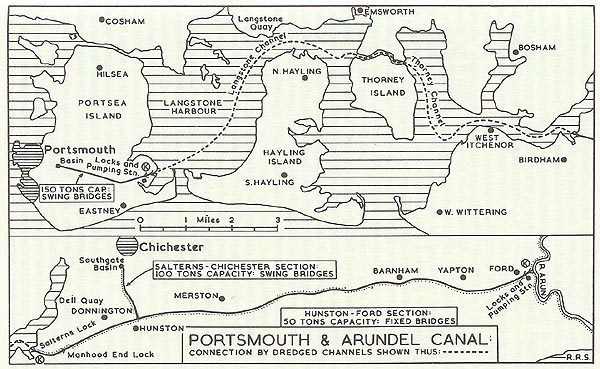 A small but important remnant of the old inland route from London to Portsmouth is being restored as a leisure waterway linking historic Chichester to the sea.
A small but important remnant of the old inland route from London to Portsmouth is being restored as a leisure waterway linking historic Chichester to the sea.
What is known today as the Chichester Canal is in fact part of the former Portsmouth & Arundel Canal. This was opened in 1822 and consisted of a 12-mile canal from Ford on the River Arun to Salterns and a shorter cut from Langstone Harbour to Portsmouth Harbour, connected together by a 13-mile dredged ‘bargeway’ through the natural harbours and channels between them.
John Rennie FRS FRSE (1761 – 1822), a civil engineer, was the Surveyor and Engineer for the Chichester Canal. One of his greatest achievements included the Kennet and Avon Canal involving 70 locks.
Intended as a key link in a through route to London via the River Arun Navigation, Wey & Arun Junction Canal, River Wey and River Thames, it was not a success. By the time it was built, there was no real need for an inland route as larger and better ships, coupled with an end to hostilities with France, meant that the coastal route was an easier and cheaper option.
One of the few regular through cargoes carried was gold bullion from Portsmouth to the Bank of England, with armed guards on the barges.
The Ship Canal
A 1.5 mile branch led from Hunston on the main line of the canal to a basin in Chichester. This and the short connecting length of the main line from Salterns to Hunston were built to a larger gauge and equipped with iron swingbridges to enable coastal ships of over 100 tons to reach Chichester. This was the only part of the canal that enjoyed even a modest success, bringing in building materials and coal, and taking away manure. It carried trade until 1906, while the rest of the canal had been unused since the 1840s and fallen derelict soon after.

Transferred to the City Council in 1892 (who in turn sold it to West Sussex County Council in 1957), the surviving four miles were abandoned in 1928. The entrance lock and a short length at Salterns were retained as yacht moorings prior to the building of Chichester Marina alongside; the lock is still capable of operation and a number of houseboats are moored on this length. The remainder of the route to Chichester was leased to the local angling club and gradually silted up over the following half-century. Two main road bridges were replaced by unnavigable culverts.
Restoration: progress so far?
In the late 1970s the Portsmouth & Arundel Canal Society was formed with the aim of restoring the canal. They intended to concentrate on the length from Chichester to Salterns, and later changed their name to Chichester Canal Society (and more recently to Chichester Ship Canal Trust) to reflect this.
Taking over the lease from the anglers in 1984, the Society began by dredging Chichester Basin. Then, assisted by Waterway Recovery Group volunteers, they began to work back down the branch towards the main line, using a floating dredger with Bantam tugs and hopper barges to shift the silt. By the late 1990s they had reached the junction at Hunston and were working westwards along the main line towards Chichester Harbour. Navigation became possible to near Crosbie Bridge. The stretch from there to Salterns Lock at the Harbour awaits restoration.





